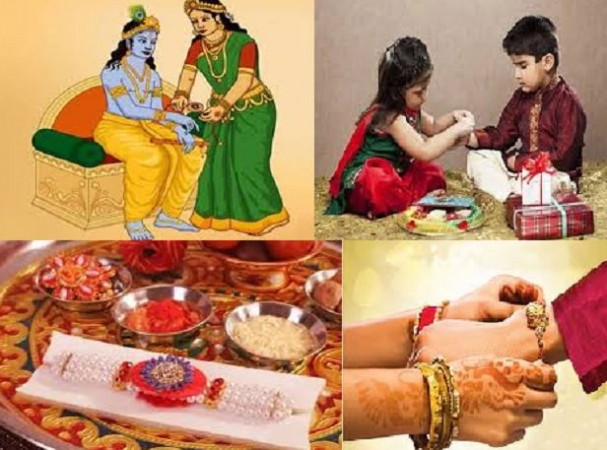
The festival of Raksha Bandhan, also known as Rakhi, is a beautiful celebration that epitomizes the bond of love and affection shared between brothers and sisters. Each year, this heartwarming occasion brings siblings closer, reinforcing their unbreakable connection. In 2023, the full moon date for Raksha Bandhan will commence at 10:58 AM on August 30 and continue until 07:05 AM on August 31. During this time, the auspicious window for Rakhi ceremonies is from 09:01 PM on August 30 to 07:05 AM on August 31. Notably, on August 31, the Sawan Purnima continues until 07:05 AM, and fortunately, there is no Bhadra Kaal during this period. Thus, sisters can lovingly tie Rakhis to their brothers on August 31. However, there has been some confusion among people regarding the timing and auspiciousness of Raksha Bandhan. Let's delve into answering some of the key questions surrounding this cherished festival.
Significance of Auspicious Timing:
The auspicious timing for Raksha Bandhan falls between 09:01 PM on August 30, 2023, and 07:05 AM on August 31. On August 31, the Sawan Purnima continues until 07:05 AM, and during this period, there is no Bhadra Kaal. Therefore, sisters can joyfully tie Rakhis to their brothers on this day. However, it's essential to consider the nuances and traditions associated with Raksha Bandhan during the ceremony.
Ideal Timing for Tying Rakhi in 2023:
August 30: 9:00 PM to 01:00 PM
August 31: Sunrise until 07:05 AM
Understanding Bhadra Kaal during Raksha Bandhan:
This year, the confusion surrounding Raksha Bandhan's date is due to the Bhadra period. Whether the festival falls on August 30 or 31 has caused uncertainty. The full moon date begins at 10:58 AM on August 30, ending at 07:05 AM on August 31, 2023. However, Bhadra Kaal is believed to coincide with the full moon's occurrence. Tying Rakhi during Bhadra Kaal is considered inauspicious in the Hindu calendar. Due to the simultaneous presence of the full moon and Bhadra on August 31, careful consideration of the Muhurta, the auspicious time, becomes crucial.
Avoiding Rakhi Tying during Bhadra:
According to Hindu scriptures, there is a story that Shurpanakha tied a Rakhi to her brother Ravana during the Bhadra period, which led to the destruction of Ravana and his clan. This narrative is one of the reasons sisters refrain from tying Rakhis during Bhadra Kaal. It's also believed that tying Rakhi during this period might impact the brother's longevity.
The Origins of Raksha Bandhan:
The tradition of Raksha Bandhan is rooted in an interesting legend from Hindu mythology. It is said that Devraj Indra and his sister Indrani first celebrated Rakhi. Indrani tied a Rakhi to her brother Devraj Indra, symbolizing their bond of love and protection. This act of sibling devotion paved the way for the celebration of Raksha Bandhan.
Choosing an Auspicious Rakhi:
Rakhi can be made from various materials, but cotton or silk threads are commonly used. Additionally, using a Kaleva, a sacred red thread, for tying Rakhi is considered auspicious. Sisters can also opt for Rakhis made from silver or gold, adding a touch of elegance to the ritual.
Preparations for Rakhi Ceremony:
Set up a plate for the Rakhi ceremony, including Roli, Chandan, Akshat (unbroken rice), and Rakshasutra.
Place a ghee lamp for the Aarti.
Initiate the ceremony by dedicating the Raksha Sutra and the worship plate to God.
Components of the Plate:
Roli or Haldi (turmeric paste)
Yogurt or a dessert offering
Unbroken Rice (Akshat)
Ghee lamp for Aarti
Rakhi
Rakhi Tying Ritual:
On Raksha Bandhan day:
Both brothers and sisters wake up early, take a bath, and dress in clean clothes.
Offer water to the Sun God and seek blessings.
Prepare a puja plate and visit a nearby temple to offer prayers.
Present a Rakhi to Lord Krishna and another to Lord Ganesha.
Tie a Rakhi to God and seek blessings.
Following this, as per the Raksha Bandhan Muhurta, make the brother sit facing the east or north direction.
Ensure that both brother and sister have their heads covered with a clean cloth while tying Rakhi.
Apply tilak (vermilion or sandalwood paste) to the brother's forehead, tie the Rakhi, and perform the Aarti.
Sweeten the brother's mouth with sweets.
After tying the protective Rakhi, seek blessings from parents or elders.
Considerations on Raksha Bandhan:
Take a thorough bath and wear clean clothes before tying Rakhi.
While tying Rakhi, adhere to the designated Muhurta for an auspicious ceremony.
Avoid breaking rice grains (Akshat) while performing worship before Rakhi tying.
Ensure the ghee lamp for Aarti is intact and not broken.
While facing the brother or sister, avoid having their faces toward the south direction, as it's believed to shorten life.
Use roli or sandalwood paste for tilak; avoid using vermilion, as it signifies marriage.
Raksha Bandhan is a celebration that encapsulates the deep love, care, and protection siblings share. The rituals and customs associated with Rakhi add a special touch to this bond, making the festival a cherished occasion for families to come together and strengthen their relationships.
Chandrayaan-3's Lunar Landing: A Tapestry of Lunar Beliefs Across Religions
Chandrayaan-3's Lunar Landing: Bridging Ancient Indian Wisdom and Modern Exploration
The Notable "Navratnas" of Emperor Akbar's Court and Tulsidas's Unique Response